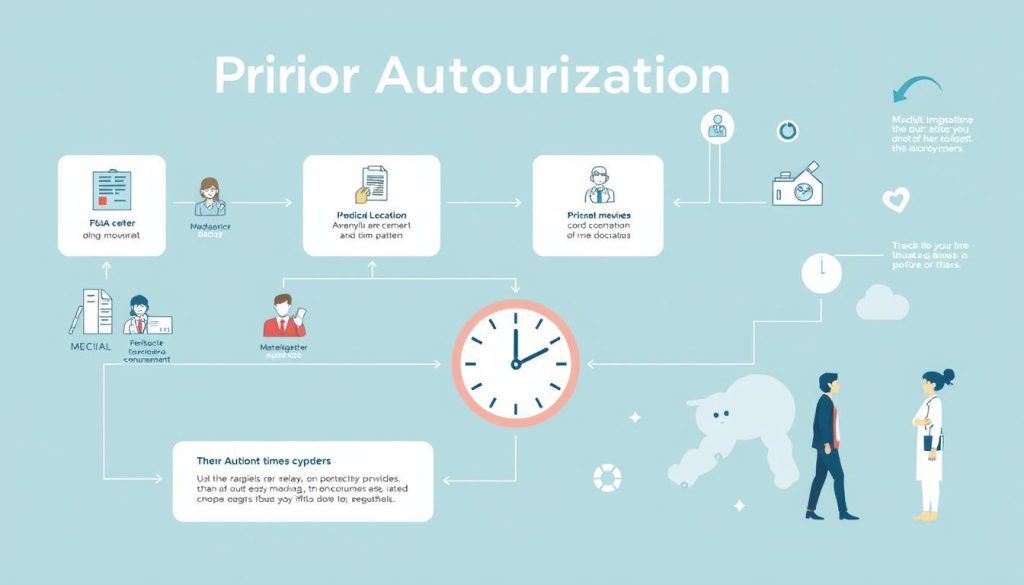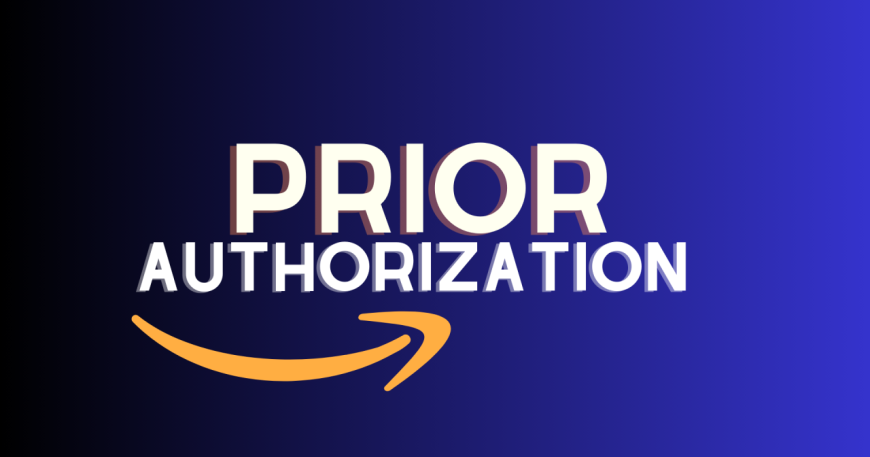In 2024, the healthcare world is changing fast. One key area getting a lot of attention is prior authorization. Did you know 94% of doctors say prior authorization has gone up a lot in five years? This shows how important it is to understand this process and how it affects patient care in the U.S.
Exploring prior authorization is crucial. It plays a big role in healthcare. This article will explain the authorization process, why insurance companies need pre-approval, and its effects on patient care. By the end, you’ll know a lot about prior authorization in 2024 and how it affects your healthcare choices.

Key Takeaways
- Prior authorization requirements have increased a lot in the last five years, affecting patient care and healthcare providers.
- It’s key to understand the authorization process, its parts, and why it’s needed to navigate healthcare well.
- The impact of prior authorization on patient care is very important. It can affect how quickly care is given, the cost, and emergency versus non-emergency situations.
- To successfully go through the authorization process, you need to get the right documents, talk to healthcare providers, and follow up on your submissions.
- The digital changes in prior authorization are shaping its future in healthcare.
Understanding Prior Authorization in Healthcare
Prior authorization is key in healthcare. It makes sure treatments are needed and covered by insurance. Knowing about it helps you move through the healthcare system better.
Key Components of the Authorization Process
The prior authorization process has a few main steps:
- Your doctor sends a request to your insurance company. They explain why the treatment is needed.
- The insurance company checks the request. They look at your medical history and the treatment plan.
- They might approve the request, deny it, or ask for more info from your doctor.
- If approved, you can get the treatment. Your insurance will cover it.
Why Insurance Companies Require Pre-approval
Insurance companies need prior authorization to manage costs. They check if treatments are really needed. This helps save money and ensures you get the right care.
Impact on Patient Care
The prior authorization process can be good or bad for patient care. It can stop unnecessary treatments and save money. But, it can also slow down getting the care you need.
| Positive Impact | Negative Impact |
|---|---|
| Ensures medical necessity | Delays access to treatment |
| Promotes cost-effective care | Increases administrative burden for healthcare providers |
| Prevents unnecessary treatments | Can lead to frustration and confusion for patients |
As a patient, understanding prior authorization is crucial. Work with your healthcare provider to get the care you need quickly and efficiently.
The Current State of Prior Authorization in 2024
In 2024, the world of prior authorization in healthcare is changing. It brings both challenges and chances for healthcare providers and patients. The push for cost management in healthcare means insurance companies are checking more closely before they approve medical services and procedures.
Automated systems are becoming more common for prior authorization. These digital tools help make the approval process faster. But, they also make things more complicated for patients, who still face a lot of paperwork and rules.
There’s also a big push for using data to make decisions. Insurance companies are using advanced analytics to find ways to save money. This means some treatments might get checked more closely, which can sometimes slow down care.
| Stakeholder | Challenges | Opportunities |
|---|---|---|
| Patients | Increased administrative burden, potential delays in care | Greater transparency in the authorization process, improved communication with providers |
| Healthcare Providers | Time-consuming paperwork, difficulty navigating evolving requirements | Streamlined digital tools, opportunities for collaboration with insurers |
| Insurance Companies | Balancing cost-saving measures with quality of care | Leveraging data analytics to optimize the authorization process |
The healthcare world is always changing, and the prior authorization process is key. Everyone needs to work together to make sure care is both good and affordable. This means talking openly and working as a team.
How Prior Authorization Affects Your Healthcare Decisions
Knowing how prior authorization impacts your healthcare choices is key. It affects how long it takes to get approval and the costs for you. Let’s look at how it shapes your healthcare path.
Timeline Expectations for Approval
The time it takes to get approval for prior authorization varies. It depends on your case’s complexity and your insurance’s speed. Usually, it’s 2-14 business days, but sometimes it’s longer. Submitting all needed documents early can speed things up.
Financial Implications for Patients
Prior authorization can affect your wallet. Without approval, you might have to pay for treatments or services yourself. This can lead to big medical bills and financial stress. Knowing your plan’s rules and working with your patient advocacy team is crucial.
Emergency vs. Non-emergency Situations
Emergency and non-emergency cases are treated differently. In urgent situations, your doctor might get approval quickly, often in 72 hours. But, non-urgent cases may wait longer and face stricter rules, risking denial of coverage.
| Scenario | Approval Timeline | Financial Impact |
|---|---|---|
| Emergency Situation | Expedited (within 72 hours) | Reduced out-of-pocket costs |
| Non-emergency Situation | Longer (2-14 business days) | Potential for denied coverage and higher costs |
Understanding prior authorization helps you make better healthcare choices. Being proactive, talking clearly with your doctors, and using patient advocacy can make this process easier.
Common Procedures Requiring Pre-approval
In healthcare, many treatments and medications need approval from insurance before they can be covered. This step makes sure the services are needed and fit the insurance rules. Knowing which procedures need approval helps patients better use the healthcare system.
Here are some common medical services that often need prior approval:
- Certain prescription medications, especially those that are considered high-cost or specialty drugs
- Advanced imaging tests, such as MRI, CT scans, and PET scans
- Inpatient hospital admissions, particularly for non-emergency situations
- Durable medical equipment, like wheelchairs, prosthetic devices, and oxygen therapy
- Surgical procedures, including elective or cosmetic surgeries
- Physical, occupational, or speech therapy visits beyond a certain number of sessions
Insurance companies need prior medical necessity for these services to ensure they are right and cost-effective. They check the prescription requirements and insurance coverage to avoid unnecessary use and keep costs down.
| Procedure | Typical Reason for Prior Authorization | Potential Impact on Patient Care |
|---|---|---|
| Specialty Medications | High cost and potential for misuse or abuse | Delayed access to critical treatments |
| Advanced Imaging Tests | Ensuring appropriate usage and ruling out unnecessary scans | Potential delays in diagnosis and treatment planning |
| Inpatient Admissions | Verifying medical necessity and preventing unnecessary hospitalizations | Disruptions in the continuum of care and increased out-of-pocket costs |
Knowing which procedures need approval helps patients prepare and advocate for their care. This ensures they get the care they need in a timely and affordable way.
Steps to Navigate the Authorization Process Successfully
Going through the prior authorization process can feel overwhelming. But, with the right approach, you can make it smoother. Here are the main steps to help you navigate it well.
Required Documentation
To start the prior authorization process, you need to collect certain documents. These usually include:
- A detailed description of the medical procedure or treatment
- Relevant clinical notes and supporting evidence from your healthcare provider
- Your insurance plan details and policy information
- Any pre-existing condition information or treatment history
Communication with Healthcare Providers
Talking well with your healthcare provider is key during this process. Make sure to:
- Discuss the authorization requirements with your provider and understand the necessary steps
- Work closely with your provider to ensure all required documentation is submitted accurately and on time
- Stay informed about the status of your authorization request and any additional information needed
Following Up on Submissions
Being persistent is important in the prior authorization process. Remember to:
- Follow up with your insurance provider regularly to check on the status of your request
- Document all communication, including dates, times, and the names of the representatives you speak with
- Be prepared to advocate for your case if the initial request is denied
By following these steps, you can confidently navigate the prior authorization process. This will help increase your chances of a successful outcome for your healthcare needs.
Digital Transformation in Prior Authorization
The healthcare world is changing fast, and so is the way we handle prior authorization. New tech is making health insurance approvals, cost management, and claims processing smoother. This makes everything more efficient for everyone involved.
Electronic systems are now key in the digital shift of prior authorization. Healthcare providers can send requests online instead of using paper. This speeds up the process and cuts down on paperwork, helping patients get the care they need faster.
Another big change is the use of tools for managing healthcare costs in the prior authorization process. Insurance companies use data and AI to make better decisions on claims. This helps them find ways to save money and approve the right treatments.
- Secure electronic data exchange between providers and insurers
- Automated decision-making based on pre-defined clinical criteria
- Real-time status updates on authorization requests
- Enhanced communication and collaboration between all stakeholders
“The digital transformation of prior authorization is not only improving efficiency but also enhancing transparency and patient-centered care.” – Dr. Jane Doe, Healthcare Informatics Expert
The healthcare industry is getting better at using technology, making prior authorization faster, clearer, and more focused on patients. With digital tools, providers and insurers can work together. They can make sure patients get the care they need quickly and at a good price.

Dealing with Prior Authorization Denials
Prior authorization denials can be really frustrating. But, knowing how to appeal and getting help from patient advocates can make a big difference. By making a strong case and fighting for your medical needs, you might get the coverage you need.
Appeal Process Overview
When your insurance denies a prior authorization, here’s what usually happens:
- You get a written notice explaining why they said no.
- Ask for your medical records and any other important documents from your doctor.
- Write a formal appeal letter that explains why you need the treatment and shows it’s necessary.
- Send in your appeal within 30-60 days of getting the denial notice.
- Keep an eye on your appeal and follow up if you don’t hear back in time.
Building a Strong Appeal Case
To win your appeal, you need a solid case. This means:
- Collecting all your medical records and treatment plans.
- Checking for mistakes in the original request.
- Explaining why you need the treatment and how it will help you.
- Using research or guidelines to back up your case.
Working with Patient Advocates
Patient advocates can really help you out. They can:
- Teach you about your rights and the appeals process.
- Help review your medical records and build a strong case.
- Talk to your insurance and doctors for you.
- Offer support and advice during the appeal.
With a patient advocate by your side, you might have a better chance of winning your appeal. This way, you can get the care you need.
Cost Management Strategies in Healthcare Authorization
In the world of healthcare, managing costs is key. Patients, doctors, and insurance companies must find a balance. They need to control costs and still get quality care. This part talks about how to manage costs in healthcare authorization.
Embracing Digital Transformation
The digital world has changed healthcare a lot. Technology helps make the prior authorization process smoother. It automates tasks and improves communication.
This makes things more efficient. It helps manage costs better.
Standardizing Approval Criteria
Insurance companies need clear rules for approval. This helps healthcare places plan better. It makes things simpler for everyone.
It also helps patients make smart choices. They can avoid treatments that cost too much.
Negotiating Coverage Contracts
Healthcare providers and insurance companies can work together. They can make deals that help everyone. This can lead to better coverage for patients.
It makes managing costs easier for providers.
Utilizing Patient Assistance Programs
Many groups help people get treatments they can’t afford. These programs are a big help. They make sure patients can get the care they need.
These strategies help make healthcare better. They make sure everyone gets the care they need without breaking the bank.

Conclusion
The prior authorization process in healthcare has grown more complex in 2024. It’s important to understand its key parts, why insurance needs it, and how it affects patient care. This knowledge helps you move through the system better.
The current state of prior authorization shows the ongoing problems for patients and healthcare providers. It points to the need for more digital changes and easier processes. Knowing the timeline, costs, and what’s urgent versus not helps you make better healthcare choices.
To successfully go through the authorization process, take proactive steps. Get all the needed documents, talk openly with your healthcare team, and follow up on your submissions. Also, be ready for denials and use patient advocacy resources. This way, you can get the care you need.
FAQ
What is prior authorization, and why is it important in healthcare today?
Prior authorization means getting approval from your insurance before getting certain medical treatments or drugs. It’s key in 2024 because it helps control costs and makes sure services are used right.
What are the key components of the prior authorization process?
The main parts of prior authorization include checking if the treatment is needed, seeing if it’s covered, and figuring out the right care level. You’ll need to send detailed info to the insurance for review.
Why do insurance companies require prior approval for certain healthcare services?
Insurance companies need prior authorization to keep costs down and make sure treatments are needed. It helps prevent misuse and overuse of services. This way, they can make smart coverage choices and manage their money better.
How does the prior authorization process impact patient care?
Prior authorization can delay or disrupt needed treatments and drugs. Patients might wait longer for approval, pay more out-of-pocket, or even have coverage denied. This can hurt the quality and continuity of their care.
What is the current state of prior authorization in 2024?
In 2024, the prior authorization scene is changing. Healthcare providers and patients face ongoing challenges. Insurance companies keep trying to save money, but the process is getting more complex. This raises concerns about the system’s efficiency and patient care.
How does prior authorization affect my healthcare decisions?
Prior authorization can affect when you get treatment, how much it costs, and the difference between emergencies and non-emergencies. Knowing the approval process and your rights is key to getting the care you need on time.
What common medical procedures and treatments require prior authorization?
Many services, like some drugs, tests, surgeries, and therapies, need prior authorization. The rules vary by plan and change, so it’s crucial to stay updated.
What steps can I take to navigate the prior authorization process successfully?
To succeed in the prior authorization process, learn what documents are needed, talk to your doctor, and check on your request’s status. Being organized and persistent can lead to a positive outcome.
How is the prior authorization process being transformed by digital technologies?
Digital tech is making the prior authorization process better. It includes online submission tools, automated decisions, and data sharing systems. These tools aim to make things faster, easier, and more open for everyone.
What can I do if my prior authorization request is denied?
If your request is denied, you can appeal. You’ll need to send more info to show why the treatment is necessary. Working with your doctor and advocates can help your appeal succeed.
How are insurance companies and healthcare providers managing the costs associated with prior authorization?
To handle prior authorization costs, insurance and healthcare are using different strategies. These aim to balance cost control with ensuring patients get the right care. Understanding these efforts can help you deal with the financial side of prior authorization.



